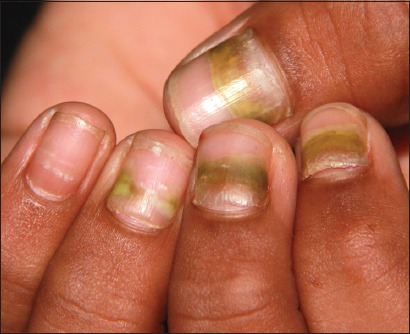Hand-foot-and mouth disease (HFMD) is a mild, contagious viral infection of children caused by a group of coxsackieviruses chiefly coxsackievirus A16 and Human enterovirus 71. It is characterized by fever, erythematous papulovesicular eruptions over palms, soles, knees, buttocks, and oral mucosa. Characteristic nail changes, onychomadesis, Beau's lines and yellowish-orange discoloration of the nail plate involving multiple fingers [Figure 1] and toenails are observed 4-8 weeks after the disease onset.[1,2] Nail changes are thought to occur due to temporary inhibition of nail matrix activity as a result of either direct inflammation from periungual HFMD lesions, the proliferation of virus in the nail matrix, or HFMD's systemic impact on the general condition.[3] No active intervention is required as changes tend to resolve spontaneously within 1-2 months [Figure 2].
Figure 1.

Onychomadesis and yellowish discoloration involving all fingernails
Figure 2.

Spontaneous remission of nail changes after 8 weeks with prominent Beau's lines
Financial support and sponsorship
Nil.
Conflicts of interest
There are no conflicts of interest.
References
- 1.Long DL, Zhu SY, Li CZ, Chen CY, Du WT, Wang X. Late-onset nail changes associated with hand, foot, and mouth disease: A clinical analysis of 56 cases. Pediatr Dermatol. 2016;33:424–8. doi: 10.1111/pde.12878. [DOI] [PubMed] [Google Scholar]
- 2.Nag SS, Dutta A, Mandal RK. Delayed cutaneous findings of hand, foot, and mouth disease. Indian Pediatr. 2016;53:42–4. doi: 10.1007/s13312-016-0788-1. [DOI] [PubMed] [Google Scholar]
- 3.Chiu HH, Liu MT, Chung WH, Ko YS, Lu CF, Lan CE, et al. The mechanism of onychomadesis (nail shedding) and Beau's lines following hand-foot-mouth disease. Viruses. 2019;11:522. doi: 10.3390/v11060522. [DOI] [PMC free article] [PubMed] [Google Scholar]


